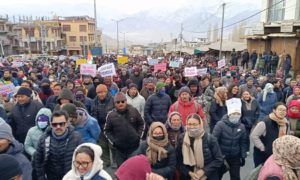In recent years, Ladakhis have been moving away from making income primarily from agriculture and instead have been opening guesthouses, restaurants, or tour companies.
For centuries, life in Ladakh would revolve around agriculture and this traditional way of living was passed on from generation to generation.
But now, it’s changing.
Nestled between the Himalayan and Karakoram ranges, Ladakh is a remote, picturesque region culturally distinct from India due to its own language and traditions.
Until 1974, Ladakh was practically unknown to the outside world as it was only then that the region was opened to tourism. Shortly after, the once isolated region saw rapid international tourism growth and a gradual modernisation of its old culture.
“Along with tourists came the army because of the conflict with China,” Dr. Mohammed Deen, president of Ladakh Environment and Health Organisation (LEHO), a welfare body promoting sustainable development building on Ladakhi traditions, tells me.
This variegated influx put an additional strain on the region’s already scarce resources and contributed to the increase in environmental pollution.

Signs showing directions to numerous guest houses in Leh, Ladakh. [FPK Photo/Katarzyna Rybarczyk.]
Climate change, continues Dr. Deen, was not an issue in the past. “We had these other challenges we were dealing with.”
But this is no longer the case.
Now, the impacts of rising temperatures are clearly visible in Ladakh. And with glaciers melting, the long-established irrigation system is endangered.

Daily life in Leh. [FPK Photo/Vikar Syed.]
So, can Ladakh overcome these socio-environmental challenges and combine modernity with tradition?
This question needs to be addressed to determine whether Ladakh is capable of preserving its unique character while at the same time not missing out on the benefits of economic growth.
Fraught Footfall
“Last year,” Dr. Deen tells me, “we got more than 400 thousand tourists in one year. It was more than our entire population!”
While the influx of tourists has undoubtedly been good for Ladakh’s economy, it has also put a strain on the region’s precious resources.
“So many tourists coming to Ladakh puts a lot of pressure on our water, land, and environment,” the LEHO president says. “Ladakh used to be self-sufficient in regards to food, clothing, and housing but today we import more than eighty per cent of the products we use.”

Tourists from India at Leh Palace in Ladkah. [FPK Photo/Vikar Syed.]
In the past, Ladakhis would grow all of their own fruit and vegetables and use yak wool to make clothes. There would also be enough wood to build houses. But when tourists started coming in large numbers the demand for these things increased and Ladakh had no choice but to start importing goods from parts of India.
In addition to using up food supplies, rising numbers of tourists have been taking their toll on water resources. To cater to the needs of international visitors, guesthouses and hotels have had to install modern sanitation facilities such as water-flush toilets and cascading showers even though normally Ladakhi families use dry toilets and have bucket baths. This, in turn, has been decreasing water availability in the region.
The impacts of tourism in Ladakh reach beyond deepening the scarcity of food resources and water, however.

Main market in Leh. [FPK Photo/Vikar Syed.]
In recent years, Ladakhis have been moving away from making income primarily from agriculture and instead have been opening guesthouses, restaurants, or tour companies.
On one hand, the diversification of sources of income can be interpreted as a good thing as new employment opportunities are being created. On the other hand, creating an economy around tourism rather than agriculture represents, at least partially, a loss of Ladakh’s old culture and traditions.
Besides, the COVID-19 pandemic revealed that this model is not fully sustainable. “People of Ladakh realised that if tourists do not come,” Dr. Deen explains, “we will have nothing to eat and no work.”

People in Leh market during an event by Dalai Lama. [FPK Photo/Vikar Syed.]
Border Belligerence
Apart from the cold desert’s troubled tourism, the hot pursuit created by the Sino-Indian faceoff on the Line of Actual Control (LAC) is equally fanning out new tensions in the region.
The Delhi-Dragon dispute first began in 1962 when China attacked Indian positions in Ladakh. The escalating tensions led to the Sino-Indian war in 1967 and later a military standoff in 1987.
With around 60,000 Chinese troops matched by the same number of Indian ones, Ladakh currently has one of the highest concentrations of armed forces in India.
Such a large military presence means large military bases, hundreds of heavy military vehicles, and fighter jets, all adding to the pollution of the environment.

Indian Army base camp in Chushul, Ladakh. [FPK Photo/Vikar Syed.]
And, just like tourists, thousands of soldiers have been consuming vast quantities of water and food supplies. To meet this ever-growing demand, Ladakhi farmers started using chemical fertilizers which interfered with the traditional organic form of farming.
Finally, some, especially young men, began choosing military service over employment in agriculture, which highlights the gradual weakening of Ladakh’s centrality of agriculture.
Climate Change
Having to adapt to the new reality of being a popular tourist destination and accommodating tens of thousands of military personnel, for years, climate change was not considered to be a main obstacle to Ladakh’s prosperity.
This is no longer the case.
“For centuries, Ladakh’s agriculture has been dependent on glaciers,” Deen continues. “During winter, snow accumulates in the mountains and in the summer it melts, giving water to those living in villages. The water is then applied to farmland. But, unfortunately, because of climate change it gets hotter and glaciers melt sooner so there are water shortages. Also, in winter we do not get as much snow as in the past so the whole system has changed.”

Labourers working near the Pangong lake road near LAC Ladakh. [FPK Photo/Vikar Syed.]
Now, rural communities face water deficits and need to think of alternative irrigation methods. Less water available reduces farmers’ crop area and consequently affects their ability to make an income from selling fruits and vegetables in local markets.
A Point of No Return?
The circumstances that Ladakh has found itself in are outside of the local communities’ control. Tourists cannot be prevented from coming, the army will stay for as long as the dispute with China remains unresolved. And, unless action is taken and policies drafted, temperatures will keep going up, making Ladakh’s glaciers melt.
Certain negative aspects of the changes Ladakh has been facing cannot be reversed but, if these new conditions are approached in a sustainable way that builds on Ladakhi culture, they can, on the whole, benefit rather than harm the region.
For instance, as observed by Dr. Deen, “there are also positive impacts of climate change. People can now grow fruits and vegetables they could not grow before such as watermelons or big apples.”

A Ladakhi family traveling in a mini truck to Leh market. [FPK Photo/Vikar Syed.]
If people of Ladakh acknowledge and embrace such opportunities, they can expand their agricultural activities, turning the changing climate conditions to their advantage.
Also, Ladakh has the potential to become an important ecotourism destination, which can help preserve the region’s ancient culture and traditions.
Promoting staying in guesthouses run by families over hotels can be a way of showing foreigners how Ladakhis live, teaching them about the importance of saving water, and encouraging them to reduce their impact on the environment. And, selling organic food products or handmade craft items in souvenir shops can provide livelihood to locals.
Preserving Ladakh’s traditional form of economy with agriculture at the center is essential for the region not to lose its unique cultural heritage.
If both the local and the tourist populations recognise the urgency of that, Ladakh will not have to redesign its agrarian economy to keep up with the times. Instead, it will be able to find a balance between the old and the new, being able to prosper without losing its identity.
Katarzyna Rybarczyk is a political correspondent for Immigration Advice Service. She covers humanitarian issues in Asia-Pacific, Africa, and the Middle East.










